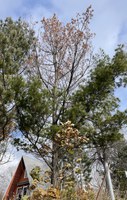Dakota Gardener: Knowing when to say goodbye
(Click an image below to view a high-resolution image that can be downloaded)
By Joe Zeleznik, Forester
NDSU Extension
In our back yard, the eastern white pine tree on the edge of the hill has been declining for the past two or three years. Last summer, it was finally clear – the top was dead and it wasn’t going to come back. There are some lower branches that are alive and healthy, but the tree will never have that main central stem that you expect in a pine tree. It’s time to take out the tree.
Knowing when to remove a tree is difficult. There are no hard-and-fast rules about tree survival following damage from insects, diseases or wind storms. Even when rabbits have eaten some of the bark from around the stem, recovery is possible, though sometimes unlikely.
That said, when the bark is missing all the way around the stem, that tree’s not going to come back. It’s toast. That’s a technical term.
My own rule-of-thumb for potential for tree recovery involves the amount of tissue lost. If less than a quarter of it is gone, then the tree is likely to survive. Whether that lost tissue is in the crown – broken branches during a wind storm – or from the bark around the circumference of the tree, if less than a quarter is damaged or missing, the tree is likely to survive.
If one-quarter-to-one-half is missing, the tree is going to be stressed and survival depends on the care that it receives afterwards. Does the tree have enough moisture, nutrients and sunlight? Are broken branches pruned properly? Is a stem protected from additional damage? These factors all come into play when figuring out if a tree is likely to survive, or not.
If more than half of the tree is gone, or if the bark is gone from more than half the circumference of the stem, then the tree’s unlikely to survive in the long run. In those situations, it might be time to remove the tree.
Nothing is guaranteed, though. Like I said earlier, these aren’t hard-and-fast rules. They’re generalizations. Nevertheless, they’re a good place to start the conversation.
Back to that pine tree in my yard, I suggested to my wife that we simply limb the tree, and leave a few branches at the top, to see if we can provide a roosting site for eagles or hawks. She liked that plan and even suggested building a nesting platform. I love that idea and we’ll give it a go. We’re turning a potential negative situation to something positive.
An old saying says that “nothing is certain except death and taxes.” Anything that’s alive now, will someday be gone, including the trees we plant in memory of those dear to us that we’ve lost.
I have to caution people about planting memorial trees – it’s a beautiful gesture, but please remember that tree survival isn’t certain. Don’t wrap up your memories of a loved one who’s no longer with you, into this other living thing – a tree – whose life is also temporary.
So what did I do when my own dad died? Of course, I planted a tree. Last winter, the woodpeckers damaged it pretty hard, and I don’t know how well it will recover in the next few years. I’ll have to take care of it.
Even the nesting platform, if it works, will only be temporary. The top of the pine tree is dead and it will slowly decay over time. And that’s okay. In the short run, this is going to be a fun experiment. And there are a bunch of oak seedlings at the base of the tree, that will someday take its place.
When one thing dies, another grows.
----
NDSU Agriculture Communication – Nov. 15, 2023
Source: Joe Zeleznik, 701-730-3389, joseph.zeleznik@ndsu.edu
Editor: Kelli Anderson, 701-231-7006, kelli.c.anderson@ndsu.edu




